"In
order to attract us,
the Lord grants us many graces
that we believe can easily
obtain Heaven for us.
We do not know, however,
that in order to grow,
we need
hard bread:
the cross, humiliation,
trials and denials."
trials and denials."
Padre Pio
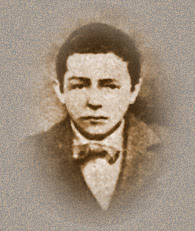 |
| Padre Pio (Francesco Forgione) at 14 |
From his
earliest years Francesco Forgione was a man of prayer. Considered a quiet boy
by the other youngsters he would seldom play with them "because they
blaspheme."
This aversion to sin would cause him to run away to pray in
the church of St. Pius V.
At other times he would sit under a tree on his
father's property and "think about God."
By age five Francesco had
already determined to become a Franciscan Capuchin, in part because of the
habit and the beard, which he liked greatly, but also moved by the grace of God
to seek perfection.
His climb
of the ladder of holiness, however, involved more than pious aspirations and
flight from the bad example of the world.
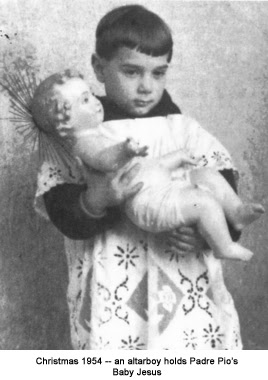 |
| Padre Pio as altar boy 1954 |
Even very young it encompassed to a
remarkable degree the battle against the flesh and against the devil. For
example, the child Francis was no stranger to mortification. Although the
family had meager rations as it was, Francesco nonetheless occasionally
deprived himself of food. And, at age nine his mother discovered him sleeping
on the floor with a rock for his pillow, a practice which apparently had been
going on for some time. Such austerity would become a hallmark of his entire life.
He also
experienced the assaults of the devil, who appeared in horrible forms in his
dreams. Later in life these attacks would take a more direct form, even
physical assaults.
January 1903
saw Francesco Forgione, age 15, enter religious life or the state of perfection
in the Franciscan Order. While religious are not by the fact of their state
necessarily perfect, the life of the three evangelical counsels (poverty,
chastity and obedience) is ordered to making them so.
Our Lord, counseling those
who wished to be perfect, offered them a means of complete surrender to God,
the giving up of the right to marry (Mt 19:12), to own material goods (Mt
19:21a), and to do what one chooses (Mt
19:21b).
It was at
this time, the entrance to the novitiate, that Francesco received the name of
Fra. Pio (Brother Pius); Fra. to indicate that he was a religious Fratello
(Italian) or Frater (Latin) and Pio to indicate by his change of name that a
new life was beginning. Only later, with priestly ordination in 1910, would he
assume the name by which he will probably be forever known, Padre Pio.
In 1910,
Brother Pio was ordained a priest by Archbishop Paolo Schinosi at the Cathedral
of Benevento. Four days later, he offered his first Mass at the parish church
of Our Lady of the Angels.
The Holy
Sacrifice of the Mass, the Eucharist was of upmost importance to a priest. Father Pio was no exception...so in touch
with the Sacrifice of Calvary that is celebrated in the Mass, his Masses would
many times last over 3 hours.
"To
this Holy Sacrifice, offered visibly by way of signs - bread and wine - but
presenting the invisible and eternal sacrifice of Christ (Heb. 10:14, Rev.
5:6), Padre Pio dedicated His most intense acts of piety, and obtained from the
Father perfect conformity to the crucified Lord.
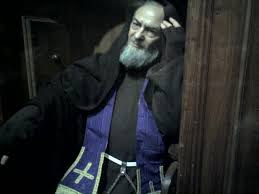 |
| Padre Pio dedicating long hours in the Confessional |
So, close
was this conformity that he lived it out even outside of the Holy Sacrifice of
the Mass, through the immolation of the service of the confessional, dedicating
long hours to the reconciliation of sinners, through a ministry of intense
sufferings offered on behalf of others, through enduring the assaults of the
devil that his spiritual children might not, and through the
mystical conformity of the stigmata, the wounds of Christ's crucifixion, as the
first priest in the history of the Church to do so.
In all these
ways Padre Pio
was both
priest and Victim
like
our High Priest Jesus Christ."
Excerpt from
http://www.ewtn.com/padrepio/mystic/spiritual.htm
On the 20th
September, 1918, Padre Pio collapsed in the chapel and was found to be bleeding
profusely from five deep wounds in his hands, feet and side. When he regained
consciousness he begged his fellow monks to keep the event secret, but word soon
spread and people flocked to the monastery from all over the country to see the
stigmata for themselves, and to confess their sins to this ‘living saint’.
During the
next few years Padre Pio was forced to endure a series of medical
investigations and attempted cures, none of which changed the character of the
wounds. He never talked about himself or complained, but when someone foolishly
asked him if his wounds hurt, he replied:
‘Do you
think that the Lord gave them
to me for a
decoration?’
This
phenomenon continued for fifty years, until the end of his life. The blood
flowing from the stigmata smelled of perfume or flowers, a phenomenon mentioned
in stories of the lives of several saints and often referred to as the odour of
sanctity.
See more at: http://www.mysticsofthechurch.com/2010/03/padre-pio-saint-who-wore-gloves.html#sthash.yPgQ1ZHt.dpuf
An interview
by
Fr. Tarcisio with
Fr. Tarcisio with
Padre Pio:
Fr.
Tarcisio: At what hour of the day do you suffer most?
Padre Pio:
During the offering of the Mass.
Fr.
Tarcisio: At what moment of the Divine Sacrifice (of the Mass) do you suffer
Most?
Padre Pio:
Always and increasingly.
Fr.
Tarcisio: During the offering of the Mass, at what moment do you suffer most?
Padre Pio:
From the Consecration to Communion.
Fr.
Tarcisio: At what part of the Mass are you scourged?
Padre Pio:
From the beginning to the end, but more intensely after the Consecrations.
Fr.
Tarcisio: During the Mass, are the pricks of thorns from the crown and the
scourging real?
Padre Pio:
What do you mean? The results are the same.
Fr.
Tarcisio: What should we do during Mass?
Padre Pio:
Repent and love.
Fr.
Tarcisio: How should we hear Mass?
Padre Pio:
In the same way that the Most Holy Virgin and the Holy women assisted. In the same way that St. John assisted at the
Eucharistic Sacrifice and the bloody one of the Cross. We priests are the sacrificers of Jesus, the
Lamb of God during the Mass, while all of paradise reverently descends on the
altar.
Padre Pio:
It is not possible to number them. You
will see them in Paradise.
So, in the
actual life experience of Padre Pio, we see that the Holy Mass is truly the
Sacrifice of Jesus on Calvary for the conversion of sinners and salvation of
souls.
Excerpts from “Padre Pio’s Mass” written by Fr. Tarcisio of Cervinara
Many thanks to Traditional Catholic Priest for the above information
http://www.traditionalcatholicpriest.com/2014/01/24/padre-pio-proves-that-the-holy-mass-is-jesus-sacrifice-on-calvary/
St. Padre
Pio demonstrated the depth of his love and loyalty to the Church when he
publicly praised and defended Pope Paul VI for his encyclical Humanae Vitae,
“Of Human Life.” 1
Upon its release in
the summer of 1968, a torrent of vilification and disobedience was unleashed
upon the Pontiff from within the Church, as well as mockery and scorn from
without. Such open rebellion against
Peter’s successor was unprecedented, and yet he had done nothing more than his
solemn duty to uphold the infallible, magisterial teaching of Catholicism
against unnatural methods of birth control.
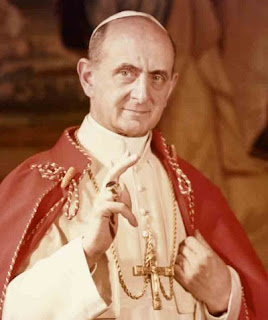 |
| Pope Paul VI |
Only two
weeks before his own death in September of that year, St. Padre Pio wrote an
inspired and moving letter to the Holy Father which was printed in the
Vatican’s official newspaper L’Osservatore Romano. 2 It is an epistle of great significance, and
will likely be part of the evidence put forth in his favor should St. Pio be
declared a Doctor of the Church. He is effusive
in his praise of the Pope’s encyclical, referring to its “lofty teachings,”
“eternal truths,” “clear and decisive words,” and its “inspired directives.”
In his
letter, St. Pio recognizes that the source of the pope’s greatest suffering is
the disobedience of so many within the Church to his magisterial teachings.
"I know
that Your heart suffers much these days on account of the happenings in the
Church: for peace in the world, for the great needs of its peoples; but above
all, for the lack of obedience of some, even Catholics, to the lofty teachings
which You, assisted by the Holy Spirit and in the name of God, have given
us."4
He
understands that the Holy Father is carrying his personal cross in Christ’s
footsteps, following the narrow way of the truth. St. Pio offers his own sufferings and prayers
so that the Pope can persevere in his mission.
"I
offer Your Holiness my daily prayers and sufferings, the insignificant but
sincere offering of the least of your sons, asking the Lord to comfort you with
His grace to continue along the direct yet often burdensome way—in defense of
those eternal truths which can never change with the times."

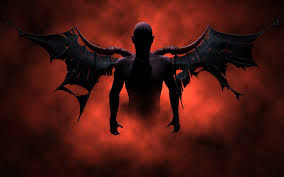



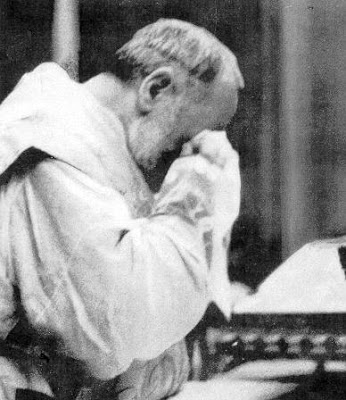
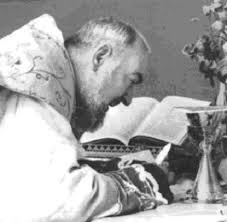

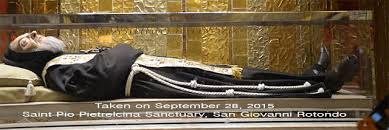
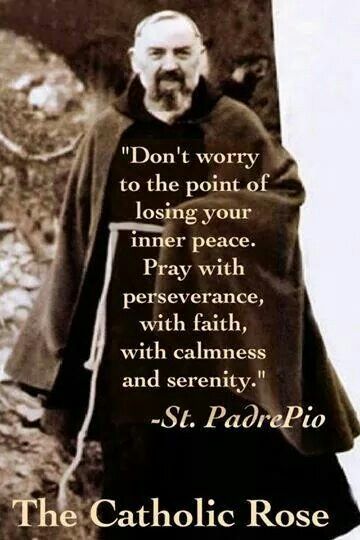
No comments:
Post a Comment